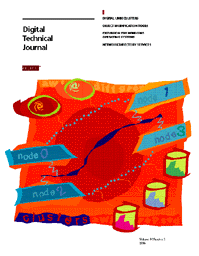|

Jane C. Blake,
Managing Editor
Digital recently announced record-breaking 30,390 tpmC
performance on a Digital UNIX cluster of 64-bit RISC AlphaServer
systems. In this issue, engineers from the UNIX team describe the
key technologies that enable these near supercomputer performance
levels as well as provide the cluster characteristics of high
availability and scalability. Also presented in this issue are
advanced UNIX programming tools for maximizing performance,
X server software that supports the Microsoft family of operating
systems, and new network directory services that simplify
management.
First defined by Digital in the early 1980s, clusters are highly
available, scalable multicomputer systems built with standard
parts and offering the advantages of single-computer systems.
Wayne Cardoza, Fred Glover, and Sandy Snaman compare clusters
with other types of multicomputer configurations and describe
the major components of Digital's newest cluster implementation,
TruCluster systems, for the 64-bit UNIX environment. The cluster
interconnect, called MEMORY CHANNEL, is critical to the cluster's
outstanding performance. MEMORY CHANNEL implements clusterwide
virtual shared memory and reduces overhead and latency by two to
three orders of magnitude over conventional interconnects.
Also developed for the Digital UNIX environment (version 4.0) are
two program analysis and optimization tools -- OM and Atom. The
tool technology originated in Digital's Western Research
Laboratory, where researchers focused on providing performance
diagnosis and improvements for large customer applications.
Software developers Linda Wilson, Craig Neth, and Mike Rickabaugh
from the UNIX Development Environment group describe the object
modification tools and the flexibility they provide over
traditional tools that are implemented in the realm of compilers.
In addition to demonstrating practical application of the tools,
the authors examine the process of transferring technology from
research to development.
For mixed operating system environments, Digital developed
Windows-based X server software, called eXcursion, to allow the
windows of a remote host running UNIX or OpenVMS to display on a
desktop running the Microsoft Windows operating system. The
latest version of eXcursion, described here by John Freitas, Jim
Peterson, Scot Aurenz, Chuck Guldenschuh, and Paul Ranauro, is
wholly rewritten to maximize graphics performance and to support
the full range of Windows platforms: Windows, Windows 95, and
Windows NT. This new version is based on the X Window System
version 11, release 6 protocol from the X Consortium.
Two network directory services that reduce complexity and
increase choices for network managers are the subjects of our
next papers. The first is designed for multiple networked
environments; Integrated Directory Services (IDS) software
integrates multiple services into one
directory-service-independent system. Margaret Olson, Laura
Holly, and Colin Strutt outline the problems that have limited
the use of directory services and the different design approaches
the team considered to simplify directory services use and make
it more attractive. They then describe the IDS extensible,
object-based framework, which comprises an application
programming interface and a service provider interface. Next,
Rich Rosenbaum and Stan Goldfarb present the Common Directory
Interface (CDI) for DECnet/OSI. Implemented as shared libraries
in the Digital UNIX and OpenVMS operating systems, CDI is
designed to give network managers a choice of directory services.
The authors describe the libraries and the registration tool set
of management operations that is layered on a specialized API.
Coming up in the Journal are papers about a new log-structured
clusterwide file system called Spiralog, the 64-bit OpenVMS
operating system, speech recognition software, and the UNIX
clusters message-passing system and its use for program
parallelization.
|
|